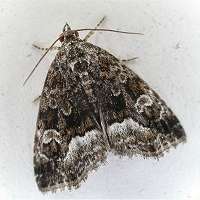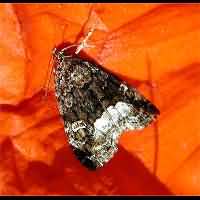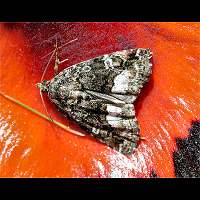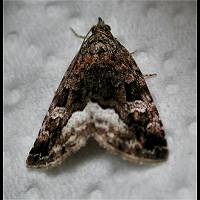Marbled White Spot Protodeltote pygarga
The Marbled White Spot is a small moth, belonging to the Owlet Moths. It doesn't look like one, though. It hits the eye by means of the extensive white spot near the rear edges of the wing. This would make it unmistakable. But alas, there is one other species with this characteristic: the Pretty Marbled. This is a very rare immigrant to Britain. You may however see it when visiting the continent. Luckily there are a few striking differences between the two species. The Marbled White Spot is less well marked, its white spot is much smaller and does not run from one side of the wing to the other, as is the case in the Pretty Marbled. The shoulders of the Pretty Marbled have large white spots, which are absent in the case of the Marbled White Spot. The latter reaches a wingspan of some 24 to 31mm only.
The Marbled White Spot lays her eggs in June mainly. In July the first caterpillars appear. They usually feed by night only. During the day they often sit motionless on the leaves or stems of the foodplant. In October the larvae move to the ground and dig a little hole, just below the surface. In the hole they spin a cocoon and in it they pupate and then overwinter as a pupa. The caterpillar is easily identified. It is reddish brown with a broad, dark dorsal line, outlined by thin yellowish or whitish borders. There are a few other lines running from head to tail over the sides. The caterpillar lacks the first two pairs of prolegs. The head is light brown with a few small dark markings. The larva reaches a length of some 18 to 23mm. It feeds on various grasses, especially False-brome and Purple Moor-grass.
In Britain the Marbled White Spot is single-brooded and flies about from late May to the end of July. On the continent south and east of Britain it is often double-brooded, even though the second brood usually gets smaller going northwards. Where two generations appear in one year the species is on the wing from May to the beginning of October. Taking into consideration the present change in climate, a second brood could appear in southern parts of England in future. The Marbled White Spot flies by night only, but it is easily disturbed during the day. It rests on walls, fences, poles, tree trunks and in lower vegetation. It comes to sugar in low numbers, but is sometimes attracted to light in vast numbers. Its usual habitat are light forests and grazy heath. Rather common in Southern England and Northwest Wales. An uncommon and very local species in most other parts of England and Wales. Rare and very local in Ireland. Common on the continent, but not found in Northern Europe, including Scotland.
The Marbled White Spot is a small moth, belonging to the Owlet Moths. It doesn't look like one, though. It hits the eye by means of the extensive white spot near the rear edges of the wing. This would make it unmistakable. But alas, there is one other species with this characteristic: the Pretty Marbled. This is a very rare immigrant to Britain. You may however see it when visiting the continent. Luckily there are a few striking differences between the two species. The Marbled White Spot is less well marked, its white spot is much smaller and does not run from one side of the wing to the other, as is the case in the Pretty Marbled. The shoulders of the Pretty Marbled have large white spots, which are absent in the case of the Marbled White Spot. The latter reaches a wingspan of some 24 to 31mm only.
The Marbled White Spot lays her eggs in June mainly. In July the first caterpillars appear. They usually feed by night only. During the day they often sit motionless on the leaves or stems of the foodplant. In October the larvae move to the ground and dig a little hole, just below the surface. In the hole they spin a cocoon and in it they pupate and then overwinter as a pupa. The caterpillar is easily identified. It is reddish brown with a broad, dark dorsal line, outlined by thin yellowish or whitish borders. There are a few other lines running from head to tail over the sides. The caterpillar lacks the first two pairs of prolegs. The head is light brown with a few small dark markings. The larva reaches a length of some 18 to 23mm. It feeds on various grasses, especially False-brome and Purple Moor-grass.
In Britain the Marbled White Spot is single-brooded and flies about from late May to the end of July. On the continent south and east of Britain it is often double-brooded, even though the second brood usually gets smaller going northwards. Where two generations appear in one year the species is on the wing from May to the beginning of October. Taking into consideration the present change in climate, a second brood could appear in southern parts of England in future. The Marbled White Spot flies by night only, but it is easily disturbed during the day. It rests on walls, fences, poles, tree trunks and in lower vegetation. It comes to sugar in low numbers, but is sometimes attracted to light in vast numbers. Its usual habitat are light forests and grazy heath. Rather common in Southern England and Northwest Wales. An uncommon and very local species in most other parts of England and Wales. Rare and very local in Ireland. Common on the continent, but not found in Northern Europe, including Scotland.









